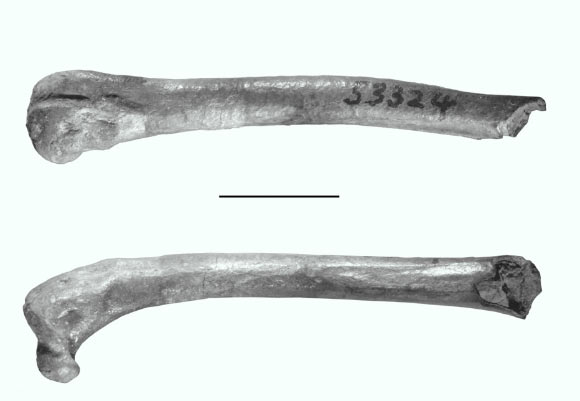A 19 to 16-million-year-old fossil of a kiwi-like bird unearthed at St Bathans, New Zealand, suggests that the kiwi is not a dwarf version of a distant ancestor, but more likely evolved from a tiny prehistoric bird that could have flown to New Zealand from Australia.

The Great spotted kiwi, Apteryx haastii: a male with a juvenile. Artwork by John Gerrard Keulemans, 1876.
The kiwi is nocturnal, flightless and comparatively large bird native to New Zealand. The smallest of all ratites (ostrich, emu, cassowaries, and rheas), it has only vestigial wings, about 5 cm in length. It is the only bird in the world that has its nostrils at the end of its beak.
Kiwis are very vulnerable to predators – about 95 per cent of the chicks are killed by cats. About 1,000 years ago, there were 12 million kiwis; by 1923, this number was down to 5 millions; 70,000 were left by the 1990s.
There are five extant species of kiwi distributed on North, South, Stewart and the nearshore islands of New Zealand.
“One of the distinguishing attributes of the kiwi is that it lays an enormous egg, which is about a quarter of the bird’s body weight and occupies most of the bird,” said Dr Trevor Worthy of Flinders University in Adelaide, who is the lead author of the paper published in the Proceedings of the 8th International Meeting of the Society of Avian Palaeontology and Evolution (paper in .pdf).
“Dr Stephen Jay Gould’s 1986 essay, which sought to explain the origins of the kiwi egg’s size, promoted the idea that the kiwi was highly derived from a large moa-like ancestor, and had shrunk in size while retaining the egg size of this ancestor.”
But the newly discovered kiwi-like bird, named Proapteryx micromeros, challenges this idea.
The fossil of Proapteryx micromeros was found at St Bathans in New Zealand’s Central Otago in April 2012.
At an estimated 234–377 g, this early Miocene bird was only 0.27-0.43 times the mass of the smallest individual (880 g) of Apteryx owenii, the smallest extant kiwi species.

Right femur of the newly discovered kiwi-like bird Proapteryx micromeros. Image credit: Worthy TH et al.
The fossil “shows us that it’s a tiny bird about one third of the size of a small kiwi today. It suggests the opposite is, in fact, the case – that the kiwi has developed towards a larger size, a trend that is seen in many birds from the early Miocene,” explained senior author Dr Paul Scofield of Canterbury Museum.
The findings are supported by the genetic evidence that the kiwi is related to the Australian emu and not the New Zealand moa, an enormous emu-like bird that became extinct some 700 years ago.
“And if, as the DNA suggests, the kiwi is related to the emu, then both shared a common ancestor that could fly. It means they were little and had wings, and that they flew to New Zealand,” Dr Worthy said.
“It was not uncommon for birds to ‘jump’ from Australia to New Zealand, citing the Mallard duck, the little banded dotterel and the cattle egret as three species which regularly fly back and forth.”
Dr Scofield added: “we need to find wing bones to put the theory beyond all doubt.”
______
Worthy TH et al. Miocene fossils show that kiwi (Apteryx, Apterygidae) are probably not phyletic dwarves. Proceedings of the 8th International Meeting of the Society of Avian Palaeontology and Evolution.Verlag Naturhistorisches Museum Wien, published December 10, 2013







